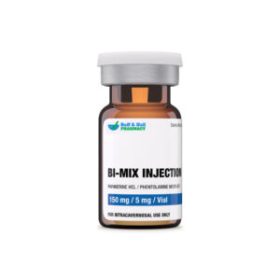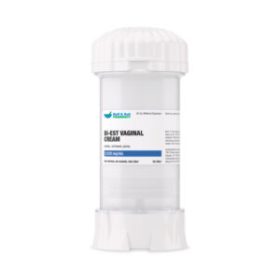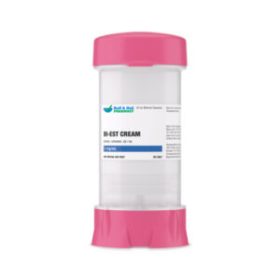NAD+ Cream (30 mL)
NAD⁺ Cream is a topical formulation designed to deliver nicotinamide adenine dinucleotide (NAD⁺) directly to the skin. It is often used as part of skin care regimens to support hydration, cellular repair, and skin health. NAD⁺ plays an essential role in energy production and antioxidant protection, and applying it through the skin is believed to help nourish and revitalize damaged or aging skin. The cream is typically recommended by healthcare professionals or skin specialists to complement other treatments.
NAD⁺ helps regulate vital processes within skin cells by promoting energy metabolism and supporting the repair of oxidative damage caused by environmental stressors. It assists in the activation of enzymes that protect against free radicals and enhance cellular regeneration. By improving mitochondrial function, NAD⁺ supports collagen synthesis, skin elasticity, and moisture retention. These effects may help reduce signs of aging, improve skin texture, and restore a healthy, radiant appearance.
This cream should not be used by individuals with known allergies to NAD⁺ or other ingredients in the formulation. People with sensitive skin, eczema, or active skin infections should consult a healthcare provider before use to avoid irritation. It is also advised to patch test the product before full application, especially for those with allergies or a history of skin reactions. Avoid applying on broken or inflamed skin unless directed by a professional.
Most users tolerate NAD⁺ Cream without issues, but some may experience mild redness, itching, or tingling at the application site, especially during initial use. In rare cases, allergic reactions like swelling, rash, or severe irritation may occur. Discontinue use and consult a healthcare provider if any persistent or concerning symptoms arise. Regular monitoring and following recommended usage help reduce the risk of adverse effects.
The effects of NAD⁺ Cream on pregnant or breastfeeding individuals have not been thoroughly studied. As a precaution, it is recommended to avoid using the product during pregnancy and lactation unless approved by a healthcare professional. Safer alternatives for supporting skin health should be considered, and medical advice should be sought to ensure the well-being of both mother and child.
Store this medication in a refrigerator between 36°F to 46°F (2°C – 8°C). Do not freeze. Protect from light. Keep all medicine out of the reach of children. Throw away any medicine after the beyond use date. Do not flush unused medications or pour down a sink or drain.
- Cantó C, Menzies KJ, Auwerx J. NAD+ Metabolism and the Control of Energy Homeostasis: A Balancing Act between Mitochondria and the Nucleus. Cell Metab. 2015;22(1):31-53. doi:10.1016/j.cmet.2015.05.023
- Johnson S, Imai SI. NAD+ biosynthesis, aging, and disease. F1000Research. 2018;7. doi:10.12688/f1000research.12120.1
- Belenky P, Bogan KL, Brenner C. NAD+ metabolism in health and disease. Trends Biochem Sci. 2007;32(1):12-19. doi:10.1016/j.tibs.2006.11.006
- Guse AH. The Ca2+-Mobilizing Second Messenger Cyclic ADP-Ribose. In: Calcium: The Molecular Basis of Calcium Action in Biology and Medicine. Springer Netherlands; 2000:109-128. doi:10.1007/978-94-010-0688-0_7
- Billington RA, Travelli C, Ercolano E, et al. Characterization of NAD uptake in mammalian cells. J Biol Chem. 2008;283(10):6367-6374. doi:10.1074/jbc.M706204200
- Massudi H, Grant R, Braidy N, Guest J, Farnsworth B, Guillemin GJ. Age-Associated Changes In Oxidative Stress and NAD+ Metabolism In Human Tissue. Polymenis M, ed. PLoS One. 2012;7(7):e42357. doi:10.1371/journal.pone.0042357
- Camacho-Pereira J, Tarragó MG, Chini CCS, et al. CD38 Dictates Age-Related NAD Decline and Mitochondrial Dysfunction through an SIRT3-Dependent Mechanism. Cell Metab. 2016;23(6):1127-1139. doi:10.1016/j.cmet.2016.05.006
- Yoshino J, Mills KF, Yoon MJ, Imai SI. Nicotinamide mononucleotide, a key NAD + intermediate, treats the pathophysiology of diet- and age-induced diabetes in mice. Cell Metab. 2011;14(4):528-536. doi:10.1016/j.cmet.2011.08.014
- Goldberger J. Public Health Reports, June 26, 1914. The etiology of pellagra. The significance of certain epidemiological observations with respect thereto. Public Health Rep. 1975;90(4):373-375. https://www.ncbi.nlm.nih.gov/pmc/articles/PMC1437745/.– LinkOpens in New Tab Accessed October 11, 2020.
- Grant R, Berg J, Mestayer R, et al. A Pilot Study Investigating Changes in the Human Plasma and Urine NAD+ Metabolome During a 6 Hour Intravenous Infusion of NAD+. Front Aging Neurosci. 2019;11. doi:10.3389/fnagi.2019.00257
- Wu J, Jin Z, Zheng H, Yan LJ. Sources and implications of NADH/NAD+ redox imbalance in diabetes and its complications. Diabetes, Metab Syndr Obes Targets Ther. 2016;9:145-153. doi:10.2147/DMSO.S106087
- Pillai JB, Isbatan A, Imai SI, Gupta MP. Poly(ADP-ribose) polymerase-1-dependent cardiac myocyte cell death during heart failure is mediated by NAD+ depletion and reduced Sir2α deacetylase activity. J Biol Chem. 2005;280(52):43121-43130. doi:10.1074/jbc.M506162200
- Csiszar A, Tarantini S, Yabluchanskiy A, et al. Role of endothelial NAD+ deficiency in age-related vascular dysfunction. Am J Physiol – Hear Circ Physiol. 2019;316(6):H1253-H1266. doi:10.1152/ajpheart.00039.2019
- Ying W, Xiong Z-G. Oxidative Stress and NAD+ in Ischemic Brain Injury: Current Advances and Future Perspectives. Curr Med Chem. 2010;17(20):2152-2158. doi:10.2174/092986710791299911
- Zhu X, Su B, Wang X, Smith MA, Perry G. Causes of oxidative stress in Alzheimer disease. Cell Mol Life Sci. 2007;64(17):2202-2210. doi:10.1007/s00018-007-7218-4
- Abeti R, Duchen MR. Activation of PARP by oxidative stress induced by β-amyloid: Implications for Alzheimer’s disease. Neurochem Res. 2012;37(11):2589-2596. doi:10.1007/s11064-012-0895-x
- Lin JB, Apte RS. NAD + and sirtuins in retinal degenerative diseases: A look at future therapies. Prog Retin Eye Res. 2018;67:118-129. doi:10.1016/j.preteyeres.2018.06.002
- O’Hollaren P. Diphosphopyridine nucleotide in the prevention, diagnosis and treatment of drug addiction. West J Surg Obstet Gynecol. May 1961.
- Mestayer PN. Addiction: The Dark Night of the Soul/ Nad+: The Light of Hope – Paula Norris Mestayer – Google Books. Balboa Press; 2019. https://books.google.com/books?id=t7qEDwAAQBAJ&lr=&source=gbs_navlinks_s.– LinkOpens in New Tab Accessed October 11, 2020.
- Braidy N, Villalva MD, van Eeden S. Sobriety and satiety: Is NAD+ the answer? Antioxidants. 2020;9(5). doi:10.3390/antiox9050425
- Gerdts J, Brace EJ, Sasaki Y, DiAntonio A, Milbrandt J. SARM1 activation triggers axon degeneration locally via NAD+ destruction. Science (80- ). 2015;348(6233):453-457. doi:10.1126/science.1258366
- Essuman K, Summers DW, Sasaki Y, Mao X, DiAntonio A, Milbrandt J. The SARM1 Toll/Interleukin-1 Receptor Domain Possesses Intrinsic NAD+ Cleavage Activity that Promotes Pathological Axonal Degeneration. Neuron. 2017;93(6):1334-1343.e5. doi:10.1016/j.neuron.2017.02.022
- Oshima J, Sidorova JM, Jr. Monnat RJ. Werner syndrome: Clinical features, pathogenesis and potential therapeutic interventions. Ageing Res Rev. 2017;33:105-114.
- Yu CE, Oshima J, Fu YH, et al. Positional cloning of the Werner’s syndrome gene. Science (80- ). 1996;272(5259):258-262. doi:10.1126/science.272.5259.258
- Fang EF, Hou Y, Lautrup S, et al. NAD+ augmentation restores mitophagy and limits accelerated aging in Werner syndrome. Nat Commun. 2019;10(1):1-18. doi:10.1038/s41467-019-13172-





